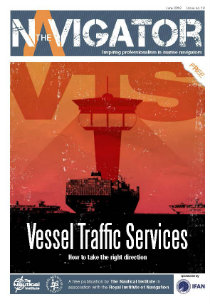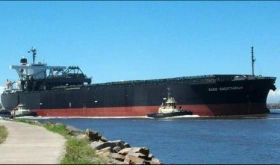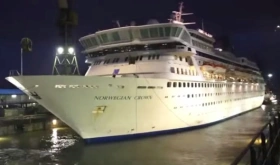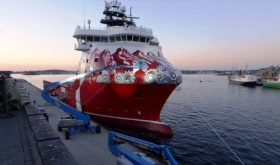On the morning of 8 January 2012, one of the permanent mooring lines holding the general cargo ship Tycoon in position in the inner moorings at Flying Fish Cove, Christmas Island, came free from its anchor. As a result, the ship moved forward and closer to the nearby terminal rock face, eventually making contact with the rock face as the weather and sea conditions deteriorated. Despite attempts to move it away, Tycoon continued to pound against the rock face. Eventually, the ship’s engine room began to flood through a tear in the hull. Shortly afterwards, the crew safely abandoned the ship. At about 1100 on 9 January, Tycoon suffered a catastrophic failure of its hull and the contents of the ship’s number two cargo hold, about 260 tonnes of bagged phosphate, were exposed to the sea.
On the morning of 6 January 2012, the 85m general cargo ship Tycoon arrived off Christmas Island following a voyage from Singapore. The ship was carrying general cargo and containers and, after cargo discharge, was due to load 3,700 tonnes of bagged phosphate for export to Malaysia.


All times referred below are local time, Coordinated Universal Time (UTC) + 7 hours.
At 0645, the Christmas Island pilot boarded Tycoon and at 0715, the first of the ship’s stern lines was run to the south breast buoy. Ship’s lines were then connected to the lamgar buoy (2), the pickup buoy (3) and the cantilever line (4). A forward ship’s line was run to the south cliff bollards (5). A ship’s line was then connected to the north cliff bollard (6), followed by another stern line to the south breast buoy (7). One of the stern lines to the south breast buoy was made fast to the ship’s bits and one was held on an aft winch. Similarly, one of the seaward head lines was made fast to the ship’s bits and one was held on a forward winch.

At 0800, cargo discharge began and it continued throughout the day. At 1645, cargo operations were completed for the day and the stevedores left the ship by barge. The barge was lifted from the water and stowed ashore, as was normal practice overnight. In preparation for Tycoon’s overnight stay, an additional forward port breast line (8) was run ashore to the south cliff bollards.
At about 2100, the pilot visited the terminal to check on Tycoon. The ship was rolling at its moorings but not sufficiently to cause the pilot any concern. The master had previously been told to contact the pilot if he needed to for any reason.
At 0630 on 7 January, the stevedores were transferred to Tycoon by barge and at 0700, discharge operations started. By 1030, discharge was completed and at 1100, loading of the bagged phosphate began.
By 1645, when the stevedores finished work for the day, 260 tonnes of bagged phosphate had been loaded. The stevedores then left the ship by barge and the barge was again recovered from the water and taken ashore. At this time, there was a 2 m sea on a north-westerly swell of about 0.5 m and the wind was north-north-easterly at about 13 knots. The pilot assessed the available weather forecasts and considered that the conditions were suitable to allow Tycoon to remain moored in position. However, the forecasts indicated to him that the weather would deteriorate late the next day and he thought that he may have to sail the ship the following afternoon, after cargo work had finished for the day.
Shortly before 2200, the pilot visited the terminal to check on Tycoon. Weather conditions had not changed from the afternoon. While the ship was rolling at the moorings, there was no chafing of the mooring lines and they appeared secure. Seeing no reason for concern, he waved to some of the ship’s crew members who were fishing on the after deck and left the terminal.
Sometime between 2300 and midnight, the stevedore manager also visited the terminal. He turned on the terminal lights and saw that the swell had picked up a little and that the ship’s inner mooring lines were slack. He too saw that the crew were fishing and they appeared to show little concern about the condition of the ship. He turned off the lights and left the terminal.
At midnight, Tycoon’s master was relieved on the bridge by the second mate.
Sometime between 0200 and 0300 on 8 January, concerned that the weather was deteriorating, the second mate called the master. When the master arrived on the bridge, he saw that the weather had worsened since he had left. He sent the second mate to the after deck to check on the condition of the mooring lines.
At 0300, the wind was 20 knots from the west-southwest. The sea was 3 m on a swell of 1 m from the northwest.
At about 0400, because of his increasing concern, the master placed the engine room staff on stand-by and the main engine was readied for immediate use. The wind was now westerly at 21 knots and the sea was 3 m on a west-north-westerly swell of 1.5 m.
At about 0420, the pin in the shackle between the cantilever line (line 4 in figure above) and its anchor chain worked free, disconnecting the line from its anchor. The master was advised that the line had gone slack and the crew recovered the ship’s mooring line and the cantilever line onto the aft centre mooring winch.
With the cantilever line gone, the ship moved forward and began to roll more violently. The sea was pushing the ship towards the rock face and crane pylon and, as the waves rebounded off the rock face, the ship was pushed back out to sea.
At about 0510, the stevedore manager arrived at the terminal. While he was there, he saw that the sea conditions were rough, the cantilever line was no longer connected to its anchor chain and the ship’s crew had recovered the line onto the after deck. He could see that Tycoon had moved about 5 m forward and that the starboard breast lines (lines 1 and 7 in figure above) to the south breast buoy were very tight. He went forward, to the shore crane, and saw the ship’s master on the bridge. The master used hand signals to indicate to the stevedore manager that the cantilever line had let go.
At about 0600, the stevedore manager tried to telephone the pilot to advise him of Tycoon’s situation. However, he could not get through because the pilot was on another telephone call. He then left the terminal to go to the stevedoring office, which was located near the jetty where the barges were launched.
At about 0615, one of Tycoon’s aft starboard breast lines connected to the south breast buoy parted. As a result, the one remaining aft starboard breast line began to take the increased strain and the ship started to move further ahead and in towards the rock face and crane pylon. The wind was now west-south-westerly at 13 knots and the sea was 4 m on a 1.9 m west-north-westerly swell.
Shortly thereafter, Tycoon moved forward about 35 m until its port bow collided with the rock face. In the confused sea and swell close inshore, the ship began to pound continually against the rock face and crane pylon.
At 0620, the pilot returned the stevedore manager’s telephone call. The stevedore manager told him that the weather was getting up and that he thought Tycoon’s master wanted to leave the moorings.
Just after 0620, the stevedore manager heard Tycoon’s master calling the pilot on VHF channel 16. He answered the call and told the master that the pilot was on his way.
At 0623, the stevedore manager telephoned the harbour master and advised him of the situation. The stevedore manager then went outside to the jetty at the southern end of Flying Fish Cove. From there, he could see the ship’s bow leaning against the rock face (figure below).
At about 0630, the pilot and some stevedores joined the stevedore manager on the jetty. They decided that they could not launch the barges in the prevailing weather conditions. The pilot then contacted Tycoon’s master on VHF channel 16 and told him to heave in on the lamgar buoy line (line 2 in figure above) in an attempt to move the ship’s bow out to seaward. He also told the master to heave in on the remaining after starboard breast line to the south breast buoy in an attempt to stop the ship from impacting the rock face and crane pylon.

The pilot and the stevedores went to the terminal where they joined the harbour master, who had just arrived.
The ship’s crew tried to heave in on the lamgar buoy line but the windlass was not powerful enough to pull the ship’s bow away from the rock face in the prevailing weather and sea conditions. The master passed this information to the pilot.
At about 0647, while the sea was pounding the ship against the rock face and crane pylon, the crew on the after deck, thinking that the master would be trying to take the ship to sea, cut through the remaining two stern lines.
At about 0710, Tycoon’s master informed the pilot that the ship’s main engine was ‘ready’. In an attempt to get the ship’s stern away from the crane pylon, the pilot asked the master to run the main engine at full astern and when the ship was moving astern, to put it to full ahead and the rudder hard over to starboard.
The master ran the main engine astern twice for a total of about 1½ minutes but the ship did not move. He made no further attempt to use the main engine.
The stevedores were asked to get two lengths of 32 mm mooring line, which were in the terminal, with a view to running a starboard breast line from the ship’s after deck to the ‘B’ buoy, located about 300 m to seaward of the south breast buoy.
At 0723, the pilot called the Royal Australian Navy ship HMAS Leeuwin, which was in the vicinity of Flying Fish Cove, and asked the ship’s commanding officer to launch his ship’s rigid hull inflatable boat (RHIB) to assist with running a mooring line from Tycoon to the ‘B’ buoy. At 0803, the RHIB was launched.
A heaving line was thrown to the crew working on Tycoon’s after deck and they secured it to the cantilever line that was still connected to the ship’s aft centre line mooring line. This line was then brought ashore and connected to the two lengths of shore line. The free end of this line was passed down to the crew of the RHIB, who then took it to the seaward ‘B’ buoy.
By this time, the ship had suffered severe damage to the port side of the accommodation. The port lifeboat had been smashed and was hanging from its davits (figure below).

At 0814, two of HMAS Leeuwin’s RHIB’s crew climbed onto the ‘B’ buoy and put the eye of the line over the buoy’s hook. The RHIB was then manoeuvred clear of the buoy and stood off Tycoon in case it was required to assist again.
While the line was being run, the ship was continually pounded against the rock face and crane pylon and, at about 0830, a 1 m vertical tear could be seen in the port side of the ship’s hull in way of the engine room.
The ship’s crew started to heave in on the line running to the ‘B’ buoy. However, the centre-line winch drum soon filled up with line, so the crew stoppered the line while they moved it onto the outer starboard winch drum. Once this was done, the crew again attempted to heave the line in.
At about 0843, the tear in the ship’s hull in way of the engine room had grown to about 2 m in length and had opened up to about 0.5 m in width (figure below).
At about 0900, torrential rain began to fall as a squall passed through Flying Fish Cove.
The rain and seawater started to enter the engine room through the tear in the hull and when the master was advised of this, he told the engine room staff to evacuate the engine room and come to the bridge. He also told the crew on the after deck to stop what they were doing and also come to the bridge.

At 0933, the master told the pilot and harbour master on VHF channel 16 that he wanted to abandon the ship.
By this time, there were various emergency response personnel in the terminal and a number of options were put forward to facilitate getting the crew safely off the ship. Following a suggestion from the coxswain of HMAS Leeuwin’s RHIB, it was decided that the master should lower the ship’s starboard accommodation ladder so the crew could climb down it and jump into the sea. They would then be pulled into the RHIB.
At about 0935, HMAS Leeuwin’s commanding officer contacted HMAS Maryborough, which was also in the area at the time, and requested that its two RHIBs be launched to assist in the rescue.
At 0944, HMAS Maryborough’s RHIBs were launched and they arrived on scene a short time later.
Tycoon’s crew lowered the starboard accommodation ladder and then gathered together in lifejackets on the deck adjacent to it. At 1031, the first crew member climbed down the ladder and jumped into the sea (figure below). He was quickly pulled on board the RHIB which had come in close to the ship’s side.

By 1037, five of Tycoon’s crew members had been pulled from the sea by HMAS Leeuwin’s RHIB crew. As that RHIB backed away from the ship, one of HMAS Maryborough’s RHIBs came in to continue to pick up Tycoon’s crew members.
By 1052, all 15 crew had been rescued. Tycoon’s master was the last crew member to leave the stricken ship, taking with him a number of ship’s documents.
The conditions prevented the ship’s crew from being landed in Flying Fish Cove, so the RHIBs took them to the boat ramp at Ethel Beach, on the east coast of the island, where they were landed and provided medical attention. The master and chief mate were the only crew members who required significant medical attention. The master had injured his back while on board the RHIB and the chief mate’s blood pressure was high. They were both admitted to the island’s hospital for observation and released the next day.
For the remainder of 8 January and into 9 January, Tycoon remained wedged against the crane pylon. During that time, winds of up to 30 knots, seas of up to 5 m and swell up to 3.5 m continued to pound the ship against the rock face and crane pylon.
At about 1100 on 9 January, the ship suffered a catastrophic hull failure in way of number two hold. The starboard side of the hold collapsed inward exposing the contents of the hold to the sea (figures below). Damage to the hull in way of the engine room allowed oil and other pollutants to be washed into the sea.


On 9 January, an Australian Maritime Safety Authority (AMSA) casualty coordinator and a representative from the Western Australian Department of Transport arrived on Christmas Island to coordinate the response to the incident.
The released phosphate washed into the sea and dissipated under the action of the waves, so the clean-up centred around collecting and removing oil and related products from the nearby beach.
On 10 January, additional oil spill responders arrived on the island to manage the ongoing response and clean-up of Flying Fish Cove. Many local residents also volunteered their time to assist with the clean-up operations.
Despite repeated attempts by AMSA over the next several months to negotiate with Tycoon’s owners to remove the wreck from Flying Fish Cove, it remained in situ with no salvors appointed. The ship continued to be pounded by the sea and swell and it broke up under the action of the waves (figure below).
The wreck of Tycoon on 7 March 2012.

On 13 March, AMSA, acting on behalf of the Commonwealth of Australia, served an official wreck removal notice on Tycoon’s owner, requiring the removal of the wreck. The ship’s owner did not act on the notice. Consequently, on 11 May, AMSA signed a wreck removal contract with Titan Salvage, with the intent of recovering all removal costs from Tycoon’s owner. On 14 June, work to remove the wreck began.
The ATSB investigation report identified the following safety factors that contributed to the accident:
Vessel related factors
- The available evidence indicates that the ship’s master did not tell anyone ashore of his concerns about the safety of the ship when the weather started to deteriorate and the cantilever line came free. He also did not effectively attempt to use the ship’s main engine or mooring lines to keep the ship in position at the inner moorings.
- The ship’s crew cut the two remaining stern lines. However, they did not ask for the master’s permission to do so nor did they inform him that they had cut the lines.
Port operations related factors
- The pilot considered that the forecast deterioration in the weather and sea conditions would occur during the evening of 8 January. Consequently, when the change occurred in the early hours of 8 January, both the shore authorities and the ship’s crew were caught unprepared.
- The pin in the shackle joining the cantilever line to its anchor cable worked its way out and the line subsequently came free. As a result, the ship moved forward in the inner moorings and more weight came onto the two starboard stern lines, resulting in one of them parting and all the ship’s weight being carried by the other.
- The port operator had not implemented an effective planned inspection and maintenance program for the mooring system in Flying Fish Cove. Consequently, it had been 18 months since the underwater components of the cantilever line had been inspected. [Significant safety issue]. As a result Christmas Island Port took further preventive actions by way of enhancing its existing maintenance system, the port operator has introduced a system to fly in diving contractors to Christmas Island to complete the annual dive inspection and has commenced works to further enhance the mooring system.
- The port operator was aware that the type of locking pin arrangement on the cantilever line joining shackle was not effective in preventing the shackle’s pin from working its way free. However, the operator had not implemented a program of replacing the shackles in the entire mooring system in Flying Fish Cove with new shackles that had a more robust locking pin arrangement. [Significant safety issue]. As a result the Port Operator took further preventive actions by replacing the mooring equipment including the anchors, dumpers, chains and shackles.
- A risk assessment for mooring a ship at the inner moorings had never been undertaken. As a result, the risks associated with leaving a ship at the inner moorings overnight during the swell season were not properly identified and strategies to minimise those risks were not implemented. [Significant safety issue]. The port operator, recognizing that there is scope to enhance the coordination of information and processes to better manage safety within the port arranged for a safety training workshop to be held on Christmas Island in June 2012 and invited all users of the port who are located on the island, including stevedores and pilots. Following on from this workshop, the port operator has put in place a procedure to facilitate regular meetings of users for the purpose of identifying and managing as a group safety issues arising from the operation and use of the port. These meetings will include an assessment of the mooring system and the overall risks posed to the port and its operations.
- While the pilot provided limited advice to masters of ships visiting Christmas Island, the port operator did not provide the master of ships intending to berth using the buoys in Flying Fish Cove with any written or verbal guidance regarding berthing and unberthing arrangements and emergency contingencies. [Minor safety issue]. The port operator, during the time this post has been published, is in the process of enhancing the information made available to the pilot by preparing a Port Handbook. The handbook will be provided to the pilot to distribute to the master of each ship.
Closing this post regarding the accident of Tycoon we would like to draw the reader’s attention on the outstanding professionalism and skill of the Royal Australian Navy rigid hull inflatable boat crews, whose actions on assisting with the abandonment of the crew from Tycoon played a critical role. The following videos show the heroic efforts demonstrated by the Royal Australian Navy rescue boats crews.
Source: Australian Transport Safety Bureau














Leave a Comment